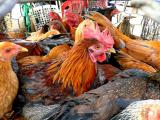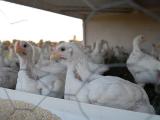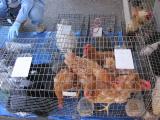China reported nine new H7N9 influenza cases today, including the third from Guangxi province, signaling a rise in disease activity in a region that borders Vietnam along with the first reports of poultry market detections there, according to a warning today from an animal health group.
The other eight new cases are from two provinces—Guangdong and Zhejiang—that are reporting the largest portion of cases in the second wave, which has now eclipsed the first wave by a growing margin. So far 174 cases have been reported in the outbreak's second wave, compared to 136 recorded during the first spike in disease activity last spring.
Nine cases from three provinces
Zhejiang province reported four case-patients, including a 67-year-old man in severe condition, a 49-year-old man in critical condition, and two women, ages 35 and 59, who are hospitalized in severe condition, according to official statements translated and posted by Avian Flu Diary (AFD), an infectious disease news blog, and FluTrackers, an infectious disease message board.
Guangdong province also reported four cases, in a 5-year-old girl and a 49-year-old man listed in stable condition and in two men, ages 42 and 56, who are hospitalized in critical condition, according to official notices posted by AFD and FluTrackers.
The case from Guangxi province is in a 5-year-old boy who is in stable condition. The boy's infection marks the third from the province, a mountainous area located southwest of the main outbreak hot spots, notable because it borders northern Vietnam.
The boy got sick a day after an H7N9 infection was confirmed in his 41-year-old mother, the South China Morning Post (SCMP), an English-language newspaper based in Hong Kong, reported today.
The new cases raise the outbreak total to 310 cases since last February, according to a running tally maintained by FluTrackers. The unofficial fatality count remained at 67.
Health officials are investigating the source of the boy's infection and noted that he had been in close contact with his mother, who is hospitalized in critical condition, according to the SCMP report. The two infections mark the second known H7N9 family cluster during the second wave of infections.
So far, human-to-human spread in those two events hasn't been confirmed, and health officials are exploring if the patients had the same poultry exposure. The World Health Organization (WHO) has said limited human-to-human spread wouldn't be surprising, especially in people who had prolonged unprotected contact. However, the agency said there is still no evidence of sustained H7N9 transmission.
WHO reports strong poultry exposure risk
The disease seems to be spreading primarily from poultry or their environments to people, a point underscored by two WHO updates today that provided additional details on 12 case reports it received from China on Feb 3 and Feb 4. All 12 of the patients had been exposed to poultry or live-poultry markets.
The 12 cases described in the WHO reports span five different provinces: Guangdong (5), Zhejiang (4), and one each from Fujian, Hunan, and Jiangsu. Three deaths are included in the WHO's report, in a 59-year-old man from Hunan province, a 76-year-old man from Guangdong, and a 52-year-old man from Guangdong.
Patient ages range from 2 to 84, and illness onsets range from Jan 21 to Jan 27. Of the nine survivors, four are in critical condition, three are in severe condition, and two have mild infections.
The two patients who have mild cases are both girls, one 2 years old and one 4 years old. So far the disease in children has been mild compared with adults—especially older ones—who often experience rapidly progressing severe pneumonia.
FAO sounds alarm over Guangxi market detections
In other H7N9 developments today, the United Nations Food and Agriculture Organization (FAO) today warned that the spread of the virus in Guangxi province's live-bird markets poses an increasing threat to Vietnam and China's other neighbors, according to a statement posted on the group's Asia and Pacific regional office Web site.
Chinese officials found the virus in live-bird markets in Guangxi between Jan 24 and Jan 28 in an area where the province's first human case was detected, the FAO said. It emphasized that Guangxi shares a border with Vietnam, and neighboring Yunnan province shares a border with Myanmar, Laos, and Vietnam.
The FAO said it has been working closely with Vietnam since June 2013 to support H7N9 surveillance in more than 60 live-bird markets in the northern part of the country.
"So far, there is no evidence that the virus is present in Vietnam or any of China's other neighboring countries in Southeast Asia," the group said. "But there are indications, based on previous experience with the H5N1 virus, that H7N9 is easily capable of circulating across borders."
The flow of poultry between China and its neighbors, combined with the possible economic impact of an outbreak, elevates H7N9 as a serious public health risk, especially during festival times, such as during the nation's current Lunar New Year celebrations, the FAO said.
Hiroyuki Konuma, the FAO's assistant director-general, in the statement urged countries in the region to review their response plans, boost surveillance, and raise awareness of the H7N9 threat. "Urgent initiatives are needed to improve biosecurity in live bird markets, and a clear response plan to disrupt the transmission cycle of the virus in case of an incursion is also necessary," he said.
The latest on poultry testing, control measures
Meanwhile, the WHO's Western Pacific Regional Office (WPRO) today provided a situation update on H7N9 disease activity from Jan 24 to Jan 31, including the results of the latest poultry testing, along with surveillance and control measures, according to reports from Chinese officials.
It said that so far this year, 33,400 samples have been collected, and eight were positive for H7N9. The virus was detected in five live-bird markets in four provinces: Guangdong, Fujian, Guangxi, and Zhejiang.
Among the latest control measures, Zhejiang province, which has recorded the most human cases, on Jan 28 said all live-animal markets in major cities and districts will be closed until Feb 15. Officials added that live-poultry markets in cities' main district areas will be permanently shuttered as of Jul 1.
The WHO statement also said Fujian province on Jan 20 temporarily suspended the transport of live poultry from areas outside its border.
See also:
Feb 5 AFD post
Feb 5 FluTrackers thread on today's cases
FluTrackers H7N9 human case count
Feb 5 SCMP story
Feb 5 WHO statement on Feb 3 reports from China
Feb 5 WHO statement on Feb 4 reports from China
Feb 5 WHO WPRO situation update




















